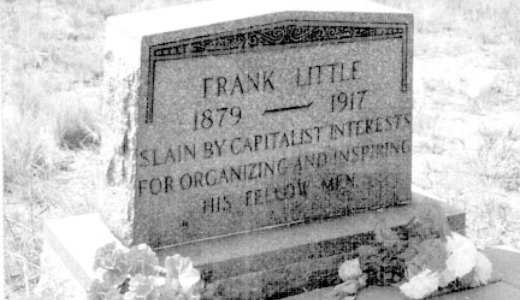
Book Review
“The Truth about the Lynching of Frank Little in Butte, Montana, 1917“
By Mike Byrnes and Les Rickey
Old Butte Publishing, Butte, Montana, 2003, 118 pp.
Order from mbyrnes@in-tch.com
“The Truth about the Lynching of Frank Little in Butte, Montana, 1917” documents in horrendous detail the awful torture and death of union organizer Frank Little in the wee hours of August 1, 1917.
As far as I know this little 118-page booklet is the first time anybody has even tried to bring these facts together.
And yet, Frank Little may be the greatest figure in American labor history. He fought for and won free speech rights before the American Civil Liberties Union was created. He successfully implemented tactics of non-violent resistance years before Dr. Martin Luther King Jr. – even years before Mahatma Gandhi used it to free India from British rule. He successfully implemented farm worker organization years before Cesar Chavez.
Frank Little was a charter member of the Socialist Party and Industrial Workers of the World. He was a hard-rock miner associated, like Bill Big Haywood, with the Western Federation of Miners until their split from the IWW. He led free speech fights among lumberjacks and farmworkers all around the West. He organized miners from Bisbee, Arizona, to the upper reaches of Montana and Minnesota.
At the time of his death, Little was Chairman of the Executive Committee of the IWW. He took the position that the IWW was a revolutionary organization and, consequently, should resist the draft and oppose America’s entry into the Great War of 1917. Actually, he lost the vote in the Executive Committee just before going to Butte, but he kept his anti-war militancy and expressed it fully in speeches to the Butte miners. The Anaconda Copper Mining company insisted that the miners go back to work, even though a large number of them had just been killed by unsafe working conditions, because copper was needed for the coming war effort. Frank Little basically told the miners, “To hell with the companies, and to hell with the war!”
Within a few nights, he was dragged out of his hotel without his clothes or his crutches, tied to the back of a Cadillac car, and dragged through the streets to a nearby railroad trestle, where he was strangled to death with a hangman’s noose. No one was ever arrested or punished. Thousands gathered for the funeral.
Byrnes and Rickey’s book must be credited with going a long way to explain why people don’t know about Frank Little. Their final chapter talks about the amazing government repression that began with Little’s death and continued through World War I and well into the 1920s. The Industrial Workers of the World offices were raided in the month following the murder. The organization and its members were hounded into near obscurity. There is no reasonable estimate of the number of unionists deported, jailed, blacklisted, or killed. Even Frank Little’s close relatives were afraid to talk about him. His personal effects, his writings, the death mask made from his face, and the movie made at his gigantic funeral are lost to history. The only remaining trace of the great Frank Little is his tombstone in Butte. It reads, “Frank Little, murdered by capitalist interests for organizing and inspiring his fellow men.”









